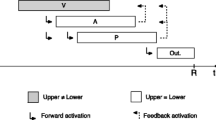Summary
Cortical areas related to perception of verbal and non-verbal stimuli were studied using VEPs. Kanji characters, line drawings (LD), or a blank were displayed. Verbal VEPs were obtained by subtracting the blank-VEPs from the Kanji-VEPs, and non-verbal VEPs by subtracting the blank-VEPs from the LD-VEPs. Both the verbal and non-verbal VEPs showed a negative peak (100–300 msec) focally over bilateral occipital, posterior temporal and parietal areas, and a positive peak diffusely over frontal halves. Difference between the non-verbal from the verbal VEPs showed an initial peak (100–200 msec) focally over bilateral occipital and posterior temporal areas, followed by a peak (200–300 msec) focally over bilateral posterior temporal areas. The frontal areas diffusely showed peaks at 100–200, 200–300 and 300–400 msec. Left-right asymmetries of both the verbal and non-verbal VEPs showed peaks between 100 and 300 msec over posterior temporal, parietal, and occipital areas. Left-right asymmetries of the subtraction to the non-verbal from the verbal VEPs showed a peak (100 msec) over occipital and parietal areas, and a broader peak over posterior temporal area (100–200 msec). Bilateral occipital, posterior temporal, and parietal areas are focally activated by the two perceptions (100–300 msec), while frontal areas are activated diffusely. Further, different processes may be focally involved between the hemispheres over occipital (100–200 msec) and posterior temporal (100–200 and 200–300 msec) regions. Initial left-right asymmetries of the subtracted VEP between the two perception would occur over occipital and parietal areas (100 msec) and last for 200 msec over posterior temporal area.
Similar content being viewed by others
References
Iwata, M. Neural mechanism of reading and writing in the Japanese language. Funct. Neurol., 1986, 1: 43–52.
Kawahata, N., Nagata, and K., Shishido, F. Alexia with agraphia due to the left posterior inferior temporal lobe lesion-neuropsychological analysis and its pathogenetic mechanisms. Brain Lang., 1988, 33: 296–310.
Kawamura, M., Hirayama, K., Hasegawa, K., Takahashi, N., and Yamaura, A. Alexia with agraphia of kanji (Japanese morphograms). J. Neurol. Neurosurg. Psychiatry, 1987, 50: 1125–1129.
Levy, J. A review of a genetic component in the determination of handedness. Behavior Genetics, 1976, 6: 429–453.
Mochizuki, H., and Ohtomo, R. Pure alexia in Japanese and agraphia without alexia in Kanji. The ability dissociation between reading and writing in kanji vs kana. Arch Neurol., 1988, 45: 1157–1159.
Ojemann, G. A., Fried, I., and Lettich, E. Electrocorticographic correlates of language. I. Desynchronizations in temporal language cortex during object naming. Electroencephalogr. Clin. Neurophysiol., 1989, 73: 453–463.
Oldfield, R. C. The assessment and analysis of handedness: the Edinburgh inventory. Neuropsychologia, 1971, 9: 97–113.
Soma, Y., Sugishita, M., and Kitamura, K. Lexical agraphia in the Japanese language. Pure agraphia for Kanji due to left posteroinferior temporal lesions. Brain, 1989, 112: 1549–1561.
Yokota, T., Ishiai, S., Furukawa, T., and Tsukagoshi, H. Pure agraphia of kanji due to thrombosis of the Labbé vein. J. Neurol. Neurosurg. Psychiatry, 1990, 53: 335–338.
Author information
Authors and Affiliations
Rights and permissions
About this article
Cite this article
Shimoyama, I., Morita, Y., Uemura, K. et al. Verbal versus non-verbal visual evoked potentials: Kanji versus line drawings. Brain Topogr 5, 35–39 (1992). https://doi.org/10.1007/BF01129968
Accepted:
Issue Date:
DOI: https://doi.org/10.1007/BF01129968




